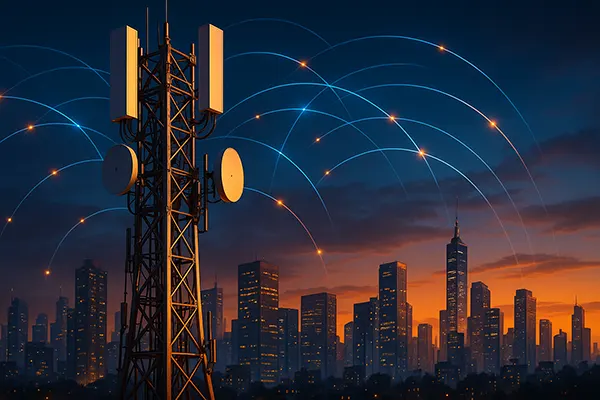6G Technologies: Terahertz Networks and Beyond

The evolution of wireless communication has always been marked by technological leaps that change the way societies connect. From the early days of analogue telephony to today’s 5G networks, each generation has not only increased speed but also expanded possibilities. Now, the world is turning its attention towards 6G, with research accelerating across Asia, Europe and North America. At the heart of this new chapter lies terahertz (THz) spectrum, which promises an unprecedented level of connectivity. But 6G is not just about higher speeds; it is a vision of integrating communication, intelligence, and sensing into a seamless global network by the mid-2030s.
The Terahertz Spectrum and Its Potential
The terahertz band, ranging roughly from 100 GHz to 10 THz, has long been considered the “last frontier” of wireless communication. Unlike 5G frequencies, THz waves provide massive bandwidth, enabling data rates potentially in excess of 1 Tbps. This level of speed can support advanced applications such as holographic communication, digital twins of entire cities, and seamless integration of augmented and virtual reality in everyday life.
However, THz signals face challenges, particularly in propagation distance and penetration. They are highly susceptible to absorption by the atmosphere and obstacles, limiting their use in large open environments without innovative solutions. To overcome these limitations, researchers are exploring technologies like reconfigurable intelligent surfaces, ultra-dense networks, and satellite-assisted THz transmission to ensure reliable coverage.
Countries such as Japan, South Korea, China, the United States, and members of the European Union are investing billions into THz research and standardisation. These efforts highlight the recognition that 6G will not be a simple upgrade but rather a radical transformation of how wireless communication systems are designed and deployed.
Applications Enabled by Terahertz Networks
One of the most discussed applications of THz networks is real-time holographic telepresence. Unlike current video calls, holographic communication would allow life-size, three-dimensional projections of people in meetings, education, and entertainment, requiring ultra-high throughput and near-zero latency.
Another application is the development of immersive extended reality (XR) ecosystems. With 6G, users could access XR content with a level of detail and fluidity that mirrors physical reality. Such systems would transform industries ranging from healthcare, where remote surgeries could be performed with precision, to manufacturing, where virtual models guide complex processes.
In addition, THz networks would enhance autonomous mobility. Vehicles, drones, and robotic systems could exchange vast amounts of sensory data in milliseconds, improving coordination and safety. This kind of connectivity would be essential for smart cities, logistics networks, and future defence systems.
Artificial Intelligence as the Core of 6G
Unlike previous generations, 6G is expected to integrate artificial intelligence into the very architecture of the network. AI will not be an added layer but a core function, optimising spectrum allocation, managing energy efficiency, and adapting to user demands in real time. This transition towards “self-sustaining” networks reflects the growing complexity of wireless ecosystems.
Machine learning algorithms are already being tested in 5G for resource management, but 6G will rely on far more advanced models capable of predicting user behaviour, adjusting coverage dynamically, and even detecting potential faults before they occur. This predictive capability could drastically reduce downtime and improve overall quality of service.
Another critical area is energy optimisation. 6G networks, with their massive bandwidth and dense infrastructure, risk being energy-intensive. AI-driven power management could reduce consumption by identifying underused nodes and reallocating resources without compromising performance, making 6G greener and more sustainable than previous generations.
Security and Ethical Dimensions of AI in 6G
The integration of AI into core network functions raises important security questions. Autonomous decision-making systems could be vulnerable to manipulation, requiring robust safeguards to ensure trustworthiness. Governments and standardisation bodies are already discussing frameworks to regulate AI-driven communication systems.
Ethical issues also emerge, particularly concerning privacy. With 6G capable of integrating sensing and positioning data alongside communication, ensuring that personal information is protected becomes crucial. Striking the right balance between innovation and individual rights will define the public acceptance of 6G technologies.
Global cooperation will be necessary to address these issues. Much like with internet governance, the international community must agree on standards that protect citizens while enabling innovation. This balance will ensure that 6G becomes a driver of progress rather than a source of division or surveillance concerns.

Beyond Communication: The Vision of 6G
While terahertz connectivity and AI form the backbone of 6G, the technology’s ambitions extend beyond traditional communication. 6G envisions networks that sense, compute, and connect simultaneously, supporting applications in medicine, climate monitoring, and space exploration. This convergence represents a fundamental redefinition of what a communication network can achieve.
Healthcare is one of the sectors set to benefit significantly. 6G-enabled biosensors could transmit medical data in real time, supporting early diagnosis and continuous monitoring of patients. For global challenges such as pandemics, such systems could improve responsiveness and coordination between countries.
Environmental applications are equally important. Terahertz sensing could be used for monitoring greenhouse gas emissions, tracking deforestation, and even studying space weather phenomena. By combining communication and sensing, 6G may play a key role in achieving sustainability goals set by the international community.
Global Roadmap and Timeline for 6G
6G development is currently in the research and pre-standardisation phase, with commercial deployment projected around 2035. Organisations such as the International Telecommunication Union (ITU), 3GPP, and regional alliances are collaborating to define technical requirements and harmonise spectrum allocation.
By 2028–2030, pilot projects and large-scale testing are expected, driven by partnerships between governments, academia, and private industry. These trials will not only refine technologies but also test their social, economic, and ethical implications in real-world conditions.
The race for 6G leadership is global, but cooperation will be essential. As with previous generations, international standardisation will ensure interoperability, allowing citizens and businesses worldwide to benefit from a new era of connectivity that promises more than speed — it promises transformation.
